Surface Laptop Studio 2
MSRP $3,300.00
“Microsoft’s Surface Laptop Studio 2 is a spec upgrade that isn’t worth the extra cash.”
Pros
- Beautiful PixelSense Flow display
- Robust hinge design
- Comfortable keyboard and trackpad
- Sharp webcam
Cons
- Expensive
- Mediocre battery life
- Middling performance in Recommended mode
It shouldn’t come as a surprise to anyone that Microsoft’s Surface Laptop Studio 2 is faster. New hardware brings higher performance, and that’s exactly what Microsoft’s latest offers. The bigger question, and one I focused in on during the course of this review, is if the laptop is truly better than the original Surface Laptop Studio and worthy of sitting among the best laptops.
That’s an important question, not only because Microsoft kept a lot of elements of the laptop the same, but also because it’s charging a much higher price. The Surface Laptop Studio 2 is $400 more expensive than the previous model for its base configuration, clocking in at $2,000. And to get a model with a discrete graphics card, which you could get for $2,100 previously, you’ll now need to spend $2,400. And you’ll need to pay upwards of $3,700 if you want the RTX 4060 in the machine.
Microsoft has addressed the few pain points of the original Surface Laptop Studio, but they don’t add up to a machine that is remarkably better than the original model. Advancements in the display, port selection, and overall performance are great, but they’re outweighed by the high pricing and regressions in battery life.
Surface Laptop Studio 2 specs
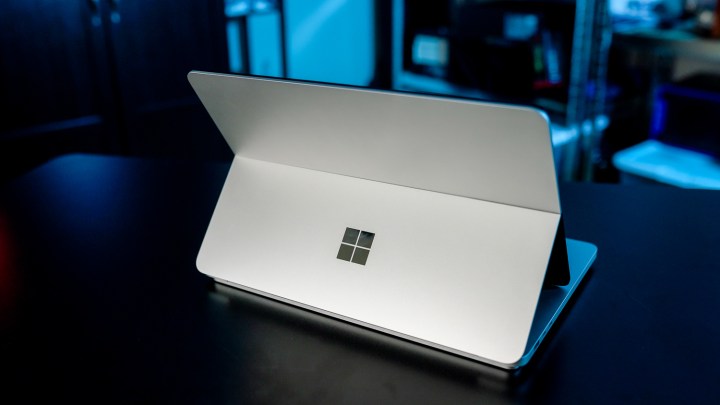
Although there are some exciting additions elsewhere, the Surface Laptop Studio 2 is mostly a spec update. Intel’s 13th-gen Raptor Lake processors and Nvidia’s RTX 40-series Ada Lovelace GPUs take center stage here, along with bumps to RAM and storage. Configuration still start at 16GB of RAM, but can now reach up to 64GB. And although the Surface Laptop Studio 2 tops out at 2TB of storage like the previous model, the base model delivers 512GB, up from the 256GB seen previously.
The bump in RAM is problematic, though. More is better if you need it, but it’s how Microsoft splits up its configurations that makes the 64GB of RAM such a hassle. In order to get a Surface Laptop Studio 2 with an RTX 4060, you need to buy a configuration with at least 1TB of storage and 64GB of RAM. That means you’re paying at least $3,300 and as much as $3,700, even if you don’t need all of that RAM or storage.
| Surface Laptop Studio 2 | |
| Dimensions | 0.86 x 9.06 x 12.72 inches |
| Weight | 4.37 pounds (4.18 pounds with integrated graphics) |
| Processor | Intel Core i7-13700H (14 cores, 20 threads, 5GHz) |
| Graphics | Nvidia RTX 4060 (80W TGP) |
| RAM | 64GB LPDDR5x |
| Display | 2,400 x 1,600 14.4-inch PixelSense Flow display, 120Hz |
| Storage | 1TB PCIe Gen4 SSD |
| Touch | 10-point multi-touch |
| Ports | 2x USB-C w/ Thunderbolt 4 (DisplayPort and Power Delivery), 1x USB-A 3.1, 1x MicroSD card reader, 1x 3.5mm headphone jack |
| Wireless | Wi-Fi 6E, Bluetooth 5.3 |
| Webcam | 1080p webcam with Windows Hello and Windows Studio Effects |
| Operating system | Windows 11 Home |
| Battery | 58WHr |
| Price (as configured) | $3,300 |
It doesn’t make much sense. There’s a good argument you need an RTX 4060, but don’t need 64GB of RAM. Similarly, 1TB or 2TB of storage is great out of the gate, but you can replace the SSD in the Surface Laptop Studio 2. Microsoft doesn’t offer any options to reduce the price if you want to upgrade the storage on your own.
Interestingly, the sole configuration with Nvidia’s RTX 2000 Ada (a workstation-class GPU) comes with only 32GB of storage and a 1TB SSD, despite being $3,600. Something is seriously off with the pricing of these higher-end configurations.
Lower down the stack, pricing is more sensible, with $2,000 being the base price. For that, you’ll get 16GB of RAM, 512GB of storage, and integrated graphics. You’ll need to spend an extra $400 if you want an Nvidia RTX 4050, and another $400 on top of that if you want 32GB of RAM and a 1TB SSD. That’s still $200 cheaper, however, than upgrading the 14-inch MacBook Pro M2 Pro with a 1TB SSD and 32GB of RAM.
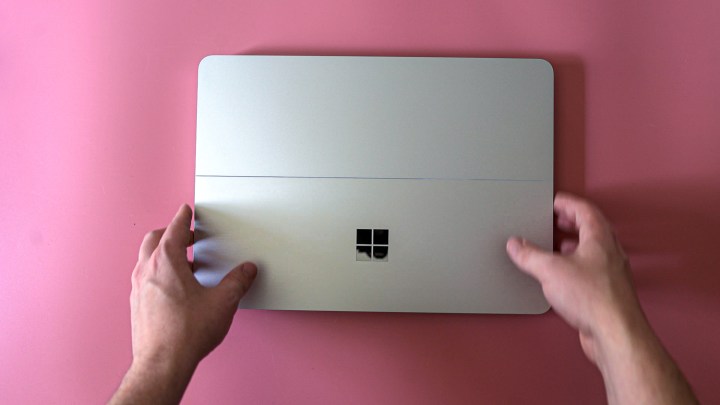
Pricing isn’t out of sorts compared to the 14-inch MacBook Pro, with the Surface Laptop Studio 2 arriving slightly cheaper depending on your configuration. However, it’s much higher than competing Windows laptops like the Dell XPS 15. For the same price as the cheapest RTX 4060 configuration of the Surface Laptop Studio 2, you can get a Dell XPS 15 with an Intel Core i9-13900H, RTX 4070, 64GB of memory, 2TB of storage, and a 3.5K OLED touch display.
The price is high for the Surface Laptop Studio 2, but the bigger issue here is customization options. You’re forced to spend more in order to gain a single spec, often paired with other components you might not need that drive up the price.
The Surface advantage

Only on Macs do you see such a seamless marriage of hardware and software, and one of the areas where the Surface Laptop Studio 2 stands out is delivering a similar experience. That’s true of all Surface devices, but it’s worth highlighting on the Laptop Studio 2 as well.
Windows Hello 2.0 signs you in before you can blink. The touchpad never misreads gestures. Windows Studio Effects look fantastic with the ultra-sharp webcam. And the Adaptive Touch feature, which allows you to use basically any surface as an input on the trackpad, truly delivers what Microsoft is calling “the most inclusive trackpad ever.”
There’s a premium experience to using the Surface Laptop Studio 2 that other Windows machines just can’t match, no matter how much more powerful or cheaper they are. For instance, the rounded corners of Windows 11 are matched perfectly with the rounded corners of the PixelSense Flow display.
The Surface Laptop Studio 2’s signature modularity stands out more too. Just like the previous model, you have Stage Mode, where you pull the display toward you, and Studio Mode, where the display lands flat on the keyboard. Like before, the metal hinge and magnets that hold this system together feel robust, but the Surface Laptop Studio 2 enjoys the enhanced tablet mode now in Windows 11.

Within a second of pulling the screen forward, Windows 11 adapts to its tablet mode that enlarges icons and pulls the taskbar down. To be clear, this is a software improvement that’s available in other convertible devices, but it feels right on the Surface Laptop Studio 2. It’s that Surface advantage, bringing together Windows with hardware in way other devices can’t touch.
Outside of the touchpad, though, there isn’t anything new here. I love Stage Mode for watching movies and playing games, and using the Surface Slim Pen 2 in Studio Mode is great, especially considering you can attach it magnetically under the front lip of the device. However, you can get that same functionality on the much cheaper original model.
The entire outer shell looks identical to the original model’s, in fact, short of a few extra ports. The aluminum body looks and feels incredible, and I still loving the stairstepping between the different layers, which makes the laptop look like a condensed stack of books. It looks great, but the Surface Laptop Studio 2 adds a tenth-of-an-inch to the thickness of the previous model, as well as nearly half a pound of weight. It ends up just shy of a full pound heavier than the MacBook Pro 14-inch, as well as 0.2 inches thicker.
PixelSense Flow

One of the big talking points for the Surface Laptop Studio 2 has been the improved PixelSense Flow display. It’s less of an improvement than Microsoft is making it out to be, though.
You’re getting the same specs overall. It’s a 14.4-inch display with a 3:2 aspect ratio and a resolution of 2,400 x 1,600. That comes out to 200 pixels per inch (PPI), which is less than the 254 PPI offered by the 14-inch MacBook Pro, and the 262 PPI available on the Dell XPS 15’s 3.5K OLED display. Still, the screen looks very sharp given the size. It’s not the best, but that hardly matters at this size and resolution.
As before, you get access to a 120Hz refresh rate, which is a fair trade-off given the lower pixel density. I’d take a smooth desktop and gaming experience any day, which isn’t offered on the 60Hz OLED display available on the Dell XPS 15. The MacBook Pro claims 120Hz, but that’s only available through Apple’s ProMotion smoothing. The Surface Laptop Studio 2 definitely has the edge here.
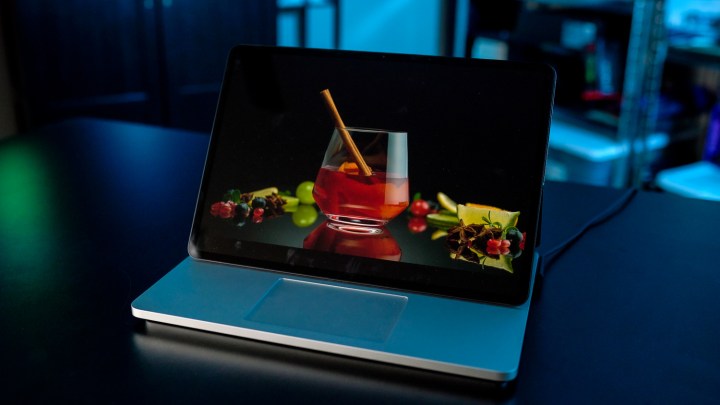
That’s all the same, but Microsoft made improvements to brightness and HDR. The screen is now certified with VESA’s DisplayHDR 400, mostly due to higher peak brightness. I measured 531 nits of peak brightness with a contrast ratio of 1,650:1, which is great. However, it still falls short of the Lenovo Slim Pro 9i with its mini-LED display.
The display looks stunning regardless, due in no small part to its glossy finish that seems particularly well equipped to keep fingerprints at bay. My main issue is color coverage. My testing produced only 77% of the DCI-P3 extended color space, which is less than the original Surface Laptop Studio’s 82%. The screen still covers 100% of sRGB and was very color accurate (less than 1 color error on average), but I don’t like seeing a regression in color coverage.
A couple of port additions

Microsoft has added two new ports on the Surface Laptop Studio 2, a USB-A 3.1 port and a microSD card slot. I know, hold your applause. They join the two USB-C ports with Thunderbolt 4, along with the 3.5mm headphone jack. It’s been interesting to see these supposed MacBook killers double back on USB-A after a little time in the sun.
I’m happy with the addition, though the ports feel very stiff. I had an external hard drive get stuck in the USB-A port several times before it smoothed out. It wasn’t kind of stuck, either; I was worried I was going to break the port. Similarly, the stiff microSD card slot made me Dell XPS 15 if I was inserting it the right way. These problems went away after using the ports a dozen times or more, but the ports still feel oddly stiff.
If it ain’t broke

As mentioned, Microsoft says the Surface Laptop Studio 2 has the “most inclusive trackpad ever,” and that’s largely due to the new Adaptive Touch feature. It disables gestures, but it’s a huge step for accessibility on laptops.
Not much has changed otherwise, though. The keyboard is still excellent with its 1.3mm of key travel, and the haptic trackpad is responsive, with four different levels of haptic feedback. Not much has changed here, but Microsoft didn’t need to change anything. The keyboard and trackpad are great, and I’m glad Microsoft didn’t mess with them.
Webcam and Windows Studio Effects
The Surface Laptop Studio 2 packs the same 1,080p webcam as the previous model, but it’s bolstered this time by Windows Studio Effects. The webcam looks fantastic, offering great color in brightly lit areas and avoiding grain in lowlight conditions.
Windows Studio Effects are what’s important here, though. For the first time, the Surface Laptop Studio 2 comes with Intel’s Gen3 Movidius 3700VC AI accelerator. Currently, that’s used in Windows Studio Effects to offer auto-framing, eye contact, and background blur features, all of which look excellent when accelerated by AI.
That’s just about the only purpose for this chip right now, though. We could see more in the future, but the AI accelerator really isn’t a reason to buy the Surface Laptop Studio 2 right now. After all, the machine includes an Nvidia GPU that has access to Nvidia Broadcast, which offers similar effects that are accelerated by AI.
Fast, but only sometimes
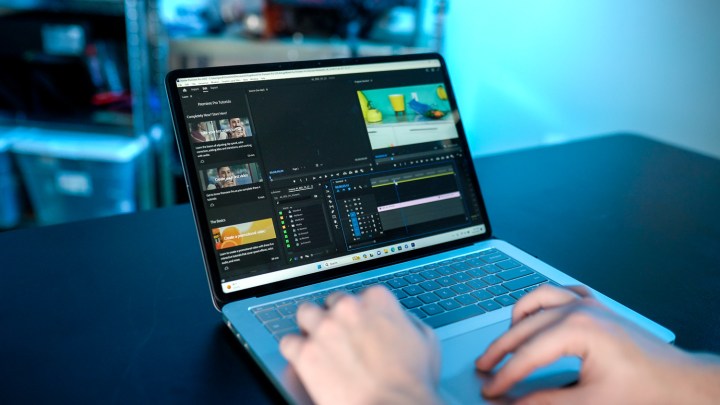
Our review sample for the Surface Laptop Studio 2 only showed up a few days before the review was to be published, so we have a more limited range of performance benchmarks. Still, from what I’ve seen so far, it’s clear this is a speedy laptop. The Core i7-13700H and RTX 4060 are a potent combo, but not in all circumstances.
Starting with the default Recommended power mode, the Surface Laptop Studio 2 gets destroyed by similarly configurated machines. The Dell XPS 15 is clearly ahead with the same processor in Cinebench, both for single-core and multi-core performance. And the M2 Max MacBook Pro 14 is even faster.
| Surface Laptop Studio 2 (Core i7-13700H) | Dell XPS 15 (Core i7-13700H) | MacBook Pro 14 (M2 Max) | |
| Cinebench R23 single/multi | 1,075 / 10,482 | 1,865 / 13,386 | 1,608 / 14,789 |
| Pugetbench for Premiere Pro | 1,047 | 709 | 1,222 |
| Handbrake (lower is better) | 104 seconds | 79 seconds | 85 seconds |
| PCMark 10 | 5,353 | 7,047 | N/A |
The same was true in Handbrake, where the Dell XPS 15 completed the transcode more than 20 seconds faster than the Surface Laptop Studio 2, as did the M2 Max. Strangely, the Surface Laptop Studio 2 managed to beat the Dell XPS 15 in Premiere Pro despite sporting a weaker GPU, though it still fell short of the MacBook Pro 14 with the M2 Max.
The power modes of the Surface Laptop Studio have a massive impact on performance. Switching to the Best Performance mode, you can see the Surface Laptop Studio 2 match the single-core and multi-core performance of the XPS 15 in Cinebench. Similarly, it falls short of the MacBook Pro’s massive core array in the multi-core test, but it takes a clear lead in the single-core test.
| Surface Laptop Studio 2 (Core i7-13700H) | Dell XPS 15 (Core i7-13700H) | MacBook Pro 14 (M2 Max) | |
| Cinebench R23 single/multi | 1,852 / 13,777 | 1,868 / 13,927 | 1,608 / 14,789 |
| Pugetbench for Premiere Pro | 912 | 1,032 | 1,222 |
| Handbrake (lower is better) | 77 seconds | 76 seconds | 85 seconds |
| PCMark 10 | 7,507 | 7,407 | N/A |
Handbrake was much better too, with the XPS 15 and Surface Laptop Studio 2 evenly matched, and the MacBook Pro 14 actually taking a slight back seat. Unfortunately, the same isn’t true in Premiere Pro, where I actually saw a slight regression in the Best Performance mode. In this app, the MacBook Pro 14 still wins the day by a significant margin.
It’s clear that any serious work should be done with the Best Performance power profile. The machine runs hotter and gets louder, but never to the point of being uncomfortable. I’m just shocked Microsoft dialed back the performance so much with the Recommended profile.
Even with this performance, the Core i7-13700H is in an awkward spot in the Surface Laptop Studio 2. It’s arriving a couple of months before Intel will start shipping its 14th-gen Meteor Lake processors, which come with AI accelerators built-in. I’m not sure why Microsoft didn’t just wait a couple of months. The Core i7-13700H inside the Surface Laptop Studio 2 performs well, but it will almost certainly be outclassed by newer Windows laptops in just a handful of weeks.
| Surface Laptop Studio 2 (RTX 4060) | Dell XPS 15 (RTX 4070) | Acer Swift X 14 (RTX 4050) | Alienware x14 R2 (RTX 4060) | |
| 3DMark Fire Strike (Balanced / Performance) | 18,849 / 20,580 | 17,956 / 18,591 | 13,846 / 16,042 | 20,070 / 20,408 |
| 3DMark Time Spy (Balanced / Performance) | 8,380 / 9,311 | 7,077 / 7,632 | 5,927 / 6,741 | 9,144 / 9,200 |
Moving on to graphics performance, I ran 3DMark Time Spy and Fire Strike to get a general sense of gaming performance. This isn’t a gaming laptop, but it certainly can run games thanks to a discrete Nvidia GPU and access to features like Deep Learning Super Sampling 3 (DLSS 3).
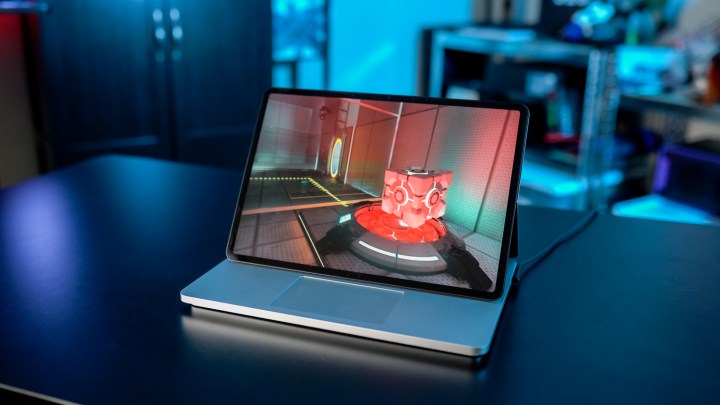
Performance is shockingly good, with the Surface Laptop Studio 2 cleanly beating the XPS 15 despite having a weaker GPU. Compared to a machine like the Acer Swift X 14 with an RTX 4050, the Surface Laptop Studio 2 looks even better. These numbers are very similar to what I saw with the Alienware x14 R2, which is a powerful enough gaming laptop in its own right, with similar specs.
Regressions in battery life
Microsoft’s claims of up to 18 hours of battery life with the Surface Laptop Studio 2 are egregious. It doesn’t get anywhere close. In our web-browsing test, the laptop lasted just over seven-and-a-half hours, and in our 1,080p local video playback test, it fell just short of 10 hours. Microsoft says you can get up to 18 hours with “typical device usage,” but if browsing the internet and playing videos isn’t typical, I’m not sure what is.
It’s almost identical to the Alienware x14 R2, which has a similar configuration. That’s a gaming laptop, though. For a more fair battle, the Dell XPS 15 9530 lasted almost two hours longer in our web-browsing test, and almost three hours longer in video playback. It’s a bloodbath when you bring in the 14-inch MacBook Pro, which lasted nearly 20 hours with the M2 Max.
I didn’t expect 18 hours out of the Surface Laptop Studio 2. I know what the components inside are capable of. What’s disappointing here is that the original Surface Laptop Studio lasted longer. It offers 10.5 hours in our web-browsing test, and as much as 12 hours with local video playback.
Caught in the middle

The Surface Laptop Studio 2 is caught in a strange spot. Although there are some improvements over the original model, those who don’t need peak power are better off buying the previous version. It’s cheaper at list price, and Microsoft is offering upwards of $500 off on configurations that are still available.
Factoring in the performance, the Surface Laptop Studio 2 stands on the foundation of its unique design. The XPS 15 is cheaper, with similar and sometimes better performance, but it doesn’t offer deep integration with Windows. The 14-inch MacBook Pro is faster with the M2 Max and cheaper when you trick it out, but it also means you’ll need to be on board with macOS.
There is a particular audience that will love the Surface Laptop Studio 2 — those that demand peak performance and want the unique form factor the machine offers. Most people will fall in one camp or the other, though, and there are far faster (and cheaper) options for them.
Editors’ Recommendations

